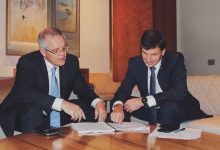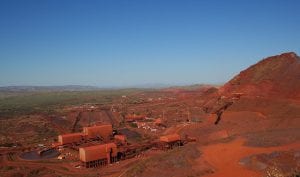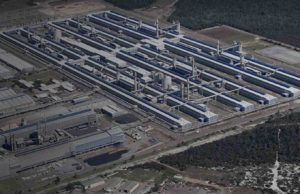New energy minister Angus Taylor has confirmed what was largely expected: that he has no interest in emission reductions under the remit handed him by prime minister Scott Morrison, and that his primary focus will be on reducing prices for consumers.
In his first public outing since his appointment on Sunday, after Morrison was elevated following a right-wing putsch against former prime minister Malcolm Turnbull.
Taylor, one of the key players in that putsch, and one of the Coalition’s harshest critics of renewable energy targets and emission reduction schemes, gave selected interviews to Murdoch publications on Thursday, along with some “media drops” to other newspapers ahead of his first speech as minister in Sydney on Thursday.
The interviews and speech confirm much of what is known about Taylor, and his new role – which sees the energy and environment portfolios split, after having been united under Turnbull.
Taylor claims he is not a climate skeptic, but he dislikes emissions reduction schemes. He claims he is not anti-renewables, he just doesn’t like schemes that encourage them like the renewable energy target.
In reality, Taylor’s position on renewables does need some explaining, particularly given his appearance in 2013 along with Craig Kelly and Alan Jones at a “Wind Power Fraud Rally” organised by an anonymous website known for its violent threats, racism and mysogony.
It was interesting to note that when he talked about Australia’s energy resources in his speech on Thursday, there was no mention of wind: “It’s ironic that in a country with an abundance of natural resources – coal, gas, water and solar – we should be in this position,” he said of the country’s high energy prices.
He later mentioned both hydro (his grandfather was chief engineer for Snowy Hydro), and solar (he says his farm has some installed) – but again no mention of wind energy from the energy minister who has campaigned against many wind projects, including one near the family property.
As for his goal as minister, it is about prices, and nothing else.
“As the new Minister for Energy, my first and only priority is to reduce power prices,” he said in his speech. He said prices had already started the downward trend, but he credited this only to lower gas prices, and a focus on retail bills – there was no credit for renewables.
This appears to ignore advice from most energy experts, including the Energy Security Council.
And new analysis released on Thursday suggests that the influx of renewables will cut wholesale prices by around half, with the huge quantities of wind and solar being brought on stream now and in the next two years. This is cutting prices in the spot market and the futures market.
This – while contrary to Taylor’s view of the world – is entirely consistent with the modelling for the original RET, through Tony Abbott’s Warburton Review, the Climate Change Authority research, the Finkel Review and the ESB modelling for the National Energy Guarantee – that renewables will bring down prices, once they are built.
And that is the key. Now that they are being built, the analysis from Green Energy Markets shows, prices are falling as more than 7,200MW of wind and solar committed since 2016 are completed.
“We’ve actually turned the corner on wholesale electricity prices and they’re now headed downward and will continue to decline substantially over the next few years,” GEM director Tristan Edis says.
Taylor, however, remains implacably opposed. He sees a future for “commercially viable” renewables – but mentions only hydro and solar, as well as coal and gas.
He says will focus on recommendations from the Australian Competition and Consumer Commission (whose chairman Rod Sims, like Taylor, is a fellow former director of consultancy group Port Jackson Partners.
These include the imposition of a price cap on retail bills, the potential underwriting of “dispatchable” generation, and attempts to stop price gouging by the big “gen-tailers”.
Perhaps he could start with the government-owned gen-tailer, Snowy Hydro – given the success of the Queensland government in bringing down prices.
He said while the ACCC did not recommend forced divestment of assets in bad cases, the government would consider it.
Taylor said that the flagged program to underwrite “new stable, low-cost generation for commercial and industrial customers” would be done “expeditiously”, but energy insiders, however, say that this is mostly talk.
There is a limit to what the government will be able to do before the next election because of the sheer complexity of what they are seeking, and because they need private contracts to exist before they can double up with their underwriting proposal. That won’t stop them talking about it though.
As for the accusations of being a climate skeptic, Taylor says: “I am not sceptical about climate science. But I am and have been for many years deeply sceptical of the economics of so many of the emissions reduction programs dreamed up by politicians, vested interests and technocrats around the world.”
That puts him firmly in the “do-nothing” camp championed by the likes of Bjorn Lomborg, the controversial Danish polemicist so admired by the Liberals when Tony Abbott was prime minister.
i agree with @AngusTaylorMP when he says he’s not a climate science denier — we’ve discussed it.
he understands the science, knows how we can mitigate climate change but has worked tirelessly to ensure we do nothing.
that’s much worse, and he’s demonstrably effective. #auspol
— simon holmes à court (@simonahac) August 29, 2018
Another interesting aspect of Taylor’s speech was his claim that having a government commitment on emissions would not guarantee certainty – as had been argued by Turnbull, Josh Frydenberg and most every utility and investor.
To some extent Taylor is right, no government can provide absolute certainty. That is not the nature of business. But who is going to invest on the basis that the government won’t, over the long term, do anything about emissions.
And while this supposedly small government, low intervention administration proposes heavy intervention on markets and pricing, it refuses to price the one thing that absolutely must be priced, and that is carbon emissions.
One of the things Taylor could do is fast-track the shift to the 5-minute settlement rule on Australia’s national Electricity Market.
The new rule – designed to encourage battery storage and demand response, and put a stop to some of the most shameless gaming of electricity markets, will not come into effect until 2021 – some 6 years after it was first proposed, and resisted by the main energy utilities.
The regulator, despite some initial resistance, eventually agreed to the change, but said it would take four years to implement, and won’t be seen until 2021.
Many say that delay is ridiculous, a view underpinned by news that in the US, in a market nearly three times bigger than Australia’s, they have achieved the switch just two years after it was first announced.
MISO (Mid-continent independent system operator) says it was essential to stop gaming in the market and encourage investment in new efficient technologies.
Finally, Taylor made it clear that the Coalition government was prepared to fight the next election on fossil fuels vs renewables, emissions targets vs prices.
He criticised former Labor Premier Jay Weatherill’s “failed experiment” in South Australia, where the 50 per cent renewable energy target had resulted in a “flood of tears”.
He didn’t mention that South Australia, according to the Australian Energy market Operator, would likely be at 73 per cent renewables by 2020, and 100 per cent by 2025, with no more tears expected.
-
- He said Labor proposes to “take Weatherill’s failed experiment national” – meaning its 50 per cent renewable energy target.”The difference between us and them could not be more stark,” he said.
- And neither could the difference between the Coalition and reality be more stark. Even AEMO in its Integrated System Plan suggests that renewables will make up 46 per cent of Australia’s electricity by 2030, just on business as usual.
- If that’s so bad, how does he propose to stop it?








